-
 Bitcoin
Bitcoin $108,489.6704
1.13% -
 Ethereum
Ethereum $2,502.0528
2.92% -
 Tether USDt
Tether USDt $1.0002
0.00% -
 XRP
XRP $2.1941
0.51% -
 BNB
BNB $655.3375
1.00% -
 Solana
Solana $151.5977
1.27% -
 USDC
USDC $0.9999
0.00% -
 TRON
TRON $0.2768
0.32% -
 Dogecoin
Dogecoin $0.1676
2.86% -
 Cardano
Cardano $0.5675
0.98% -
 Hyperliquid
Hyperliquid $40.6109
7.48% -
 Bitcoin Cash
Bitcoin Cash $500.7746
2.09% -
 Sui
Sui $2.8328
2.03% -
 Chainlink
Chainlink $13.4452
1.26% -
 UNUS SED LEO
UNUS SED LEO $9.1623
0.39% -
 Avalanche
Avalanche $18.2267
2.24% -
 Stellar
Stellar $0.2382
0.00% -
 Toncoin
Toncoin $2.8885
1.68% -
 Shiba Inu
Shiba Inu $0.0...01159
0.91% -
 Litecoin
Litecoin $87.1827
0.88% -
 Hedera
Hedera $0.1511
2.90% -
 Monero
Monero $315.4992
-0.59% -
 Polkadot
Polkadot $3.4663
2.34% -
 Bitget Token
Bitget Token $4.6118
-0.65% -
 Dai
Dai $1.0000
-0.01% -
 Ethena USDe
Ethena USDe $1.0003
0.02% -
 Uniswap
Uniswap $7.2989
4.69% -
 Pepe
Pepe $0.0...01003
5.73% -
 Aave
Aave $275.5616
7.15% -
 Pi
Pi $0.5181
-2.49%
Can the shrinking cross star on the way down be regarded as a stop-loss signal?
The shrinking cross star signals potential trend weakness but requires confirmation to avoid false signals in volatile crypto markets.
Jun 30, 2025 at 05:29 pm
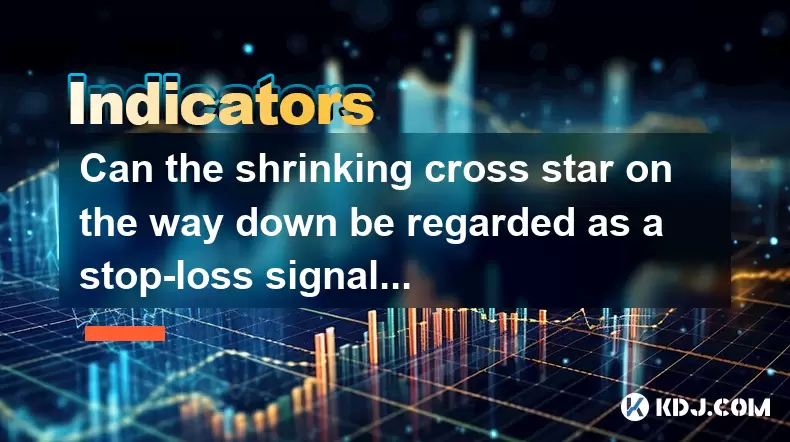
Understanding the Shrinking Cross Star Candlestick Pattern
The shrinking cross star is a candlestick pattern that typically appears during a downtrend and may signal potential market indecision or a possible reversal. This pattern consists of a large bearish candle followed by a smaller-bodied candle, often resembling a doji or spinning top, indicating diminishing momentum in the selling pressure.
In the context of cryptocurrency trading, where volatility is high and trends can reverse quickly, identifying such patterns becomes crucial for traders looking to manage risk effectively. The shrinking cross star's appearance on a chart can suggest that the bears are losing control, and bulls might be preparing to step in, although this is not always a guarantee.
Key Takeaway:
The shrinking cross star is a sign of weakening momentum during a downtrend but should not be used in isolation as a definitive stop-loss trigger.Technical Characteristics of the Shrinking Cross Star
To identify the shrinking cross star correctly, it's essential to understand its technical components:
- A strong bearish candle appears first, continuing the ongoing downtrend.
- The next candle has a significantly smaller body, often with long upper and lower shadows.
- This second candle shows hesitation among sellers and could indicate a pause in the downward movement.
This pattern suggests that while bears were dominant earlier, their strength is waning. However, in the crypto market, where price action can be erratic due to news events or whale movements, confirmation from other indicators like volume or moving averages is necessary before making any decision.
- Look at the volume accompanying the formation of the cross star. A drop in volume may support the idea of reduced selling pressure.
- Consider overlaying technical indicators such as RSI or MACD to confirm the weakening trend.
Why the Shrinking Cross Star Should Not Be Treated as a Direct Stop-Loss Signal
While the shrinking cross star indicates a possible change in trend direction, treating it as an automatic stop-loss signal can lead to premature exits from trades. In highly volatile markets like cryptocurrency, false signals are common, and relying solely on one candlestick pattern may result in unnecessary losses.
Traders must remember that candlestick patterns provide insight into market sentiment, not certainty. Therefore, using the shrinking cross star as a stop-loss trigger without additional confirmation could expose traders to early liquidation, especially if the downtrend resumes after a brief consolidation period.
- Wait for a follow-through candle after the cross star to confirm whether the trend is reversing.
- Use support and resistance levels to contextualize the pattern’s significance.
- Combine with volatility indicators like Bollinger Bands to assess the likelihood of a reversal.
Practical Steps to Incorporate the Shrinking Cross Star in Risk Management
If you're considering the shrinking cross star as part of your risk management strategy, here are actionable steps you can take:
- Monitor the pattern closely when it forms near key support levels.
- Do not place a stop-loss order immediately upon seeing the cross star; instead, wait for confirmation.
- If you're holding a short position, consider tightening your stop only if the price closes above the high of the cross star candle.
- For long positions, use the pattern as a potential entry point only after confirming bullish follow-through.
It’s also important to backtest how the shrinking cross star has performed historically in the specific cryptocurrency pair you're trading. Historical performance varies across different assets and timeframes.
- Analyze past occurrences of the shrinking cross star on BTC/USDT, ETH/USDT, or altcoin pairs.
- Observe how price reacted after the pattern formed—did it reverse or continue the trend?
- Adjust your trading plan based on empirical evidence rather than intuition alone.
How to Avoid Misinterpreting the Shrinking Cross Star
Misinterpretation of candlestick patterns is a common issue among novice traders. The shrinking cross star is no exception. One of the biggest mistakes traders make is assuming that the appearance of this pattern automatically means a reversal is imminent.
Instead, treat the shrinking cross star as a warning light, not a green light to exit or enter a trade. It serves more as a tool to help you prepare for potential changes rather than a direct instruction.
- Avoid placing stop-loss orders based solely on this pattern.
- Refrain from entering counter-trend trades unless multiple indicators align.
- Stay patient and let the market show its hand before reacting emotionally to a single candlestick.
By combining candlestick analysis with broader technical tools, you'll be better equipped to avoid costly misjudgments.
Frequently Asked Questions (FAQs)
Q: Is the shrinking cross star a bullish or bearish pattern?
A: The shrinking cross star itself is neutral—it reflects indecision. Its implications depend heavily on the surrounding price action and trend context.
Q: Can I use the shrinking cross star in conjunction with Fibonacci retracement levels?
A: Yes, many traders combine the shrinking cross star with Fibonacci levels to enhance accuracy. A cross star forming near a 50% or 61.8% retracement level can offer stronger clues about potential reversals.
Q: Does the shrinking cross star work better on higher timeframes like 4H or Daily charts?
A: Generally, candlestick patterns tend to carry more weight on higher timeframes. The shrinking cross star observed on a daily chart is considered more reliable than one on a 15-minute chart.
Q: What should I do if the shrinking cross star fails and the downtrend continues?
A: If the downtrend resumes after the pattern forms, reassess your position and consider exiting if your stop-loss level is breached. Never ignore price action just because a pattern suggested a reversal.
Disclaimer:info@kdj.com
The information provided is not trading advice. kdj.com does not assume any responsibility for any investments made based on the information provided in this article. Cryptocurrencies are highly volatile and it is highly recommended that you invest with caution after thorough research!
If you believe that the content used on this website infringes your copyright, please contact us immediately (info@kdj.com) and we will delete it promptly.
- Unlock Crypto Riches: Mining Platforms & Starter Bonuses - Your Gateway to Digital Gold!
- 2025-06-30 22:30:11
- Dogecoin, Cloud Mining, and Risk Alerts: Navigating the Meme Minefield
- 2025-06-30 22:30:11
- XRPL EVM Sidechain Mainnet: Smart Contracts Unleashed!
- 2025-06-30 22:35:12
- Emmerdale's Dog Attack Storyline: A Bite of Reality
- 2025-06-30 22:40:11
- Retail Investors, Degen Labs, and ICOs: A New Era of Meme Coin Mania?
- 2025-06-30 22:45:12
- Rekt, Ovie Faruq, and the Movement: How a Crypto Meme Became a Consumer Brand
- 2025-06-30 21:10:14
Related knowledge
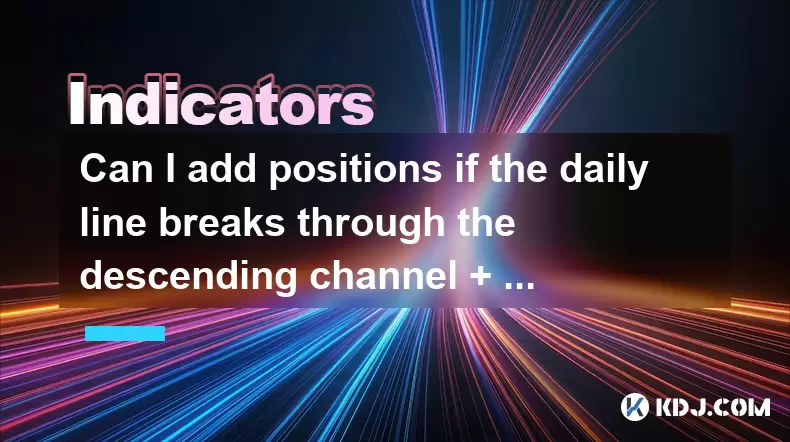
Can I add positions if the daily line breaks through the descending channel + the 30-minute moving average is in a bullish arrangement?
Jun 30,2025 at 11:00pm
Understanding the Descending Channel BreakoutWhen a daily line breaks through a descending channel, it indicates a potential shift in market sentiment from bearish to bullish. A descending channel is formed by drawing two parallel trendlines, where the upper trendline connects the lower highs and the lower trendline connects the lower lows. A breakout o...
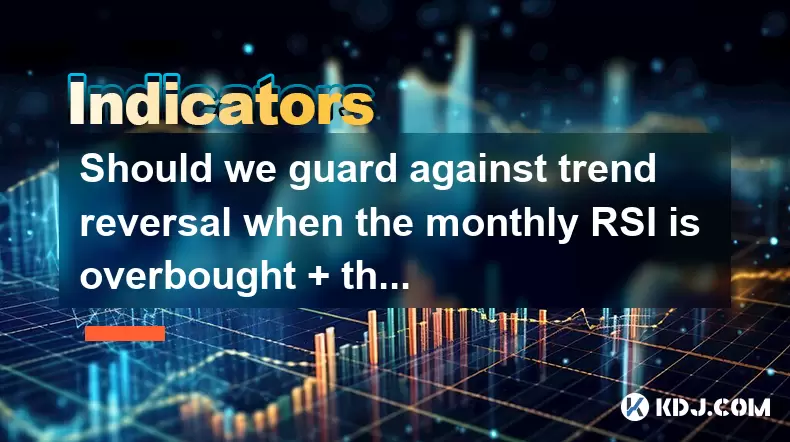
Should we guard against trend reversal when the monthly RSI is overbought + the weekly line has a long upper shadow?
Jun 30,2025 at 11:35pm
Understanding RSI Overbought Conditions in CryptocurrencyThe Relative Strength Index (RSI) is a momentum oscillator commonly used in technical analysis to identify overbought or oversold conditions in an asset. When the monthly RSI of a cryptocurrency reaches above 70, it is generally considered overbought, suggesting that the asset may be due for a pul...
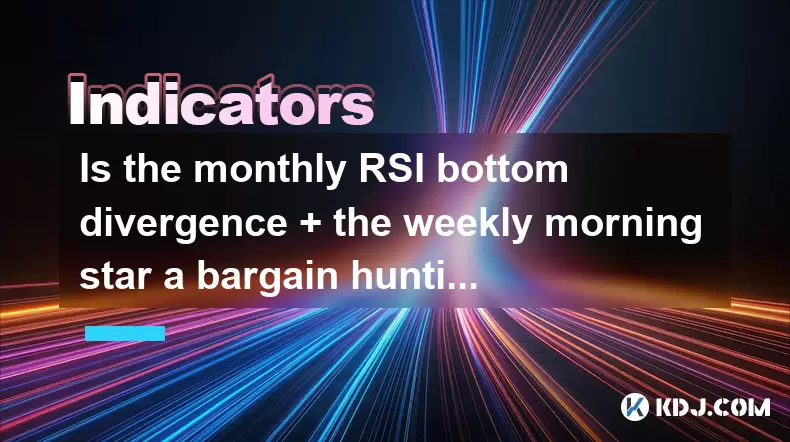
Is the monthly RSI bottom divergence + the weekly morning star a bargain hunting opportunity?
Jun 30,2025 at 09:57pm
Understanding RSI Bottom Divergence in Monthly TimeframesThe Relative Strength Index (RSI) is a momentum oscillator commonly used to identify overbought or oversold conditions in the market. When traders refer to a monthly RSI bottom divergence, they're observing a situation where the price makes a lower low, but the RSI makes a higher low on the monthl...
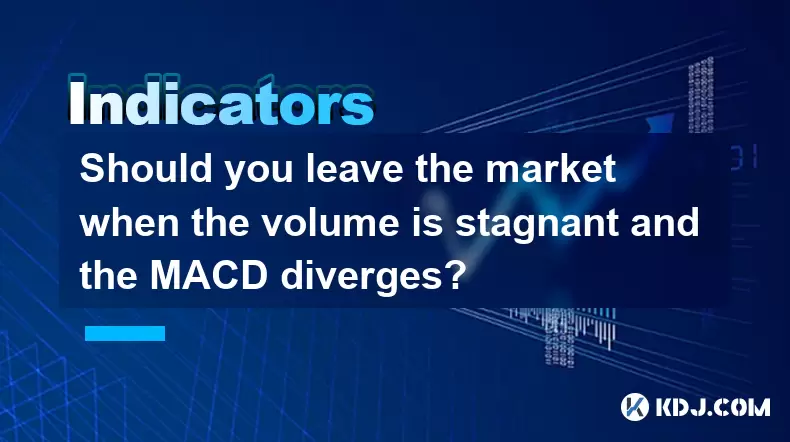
Should you leave the market when the volume is stagnant and the MACD diverges?
Jun 30,2025 at 09:36pm
Understanding Volume Stagnation in Cryptocurrency TradingIn the realm of cryptocurrency trading, volume plays a crucial role in determining the strength of price movements. When volume remains stagnant over an extended period, it suggests that neither buyers nor sellers are showing strong conviction. This often leads to sideways movement or consolidatio...
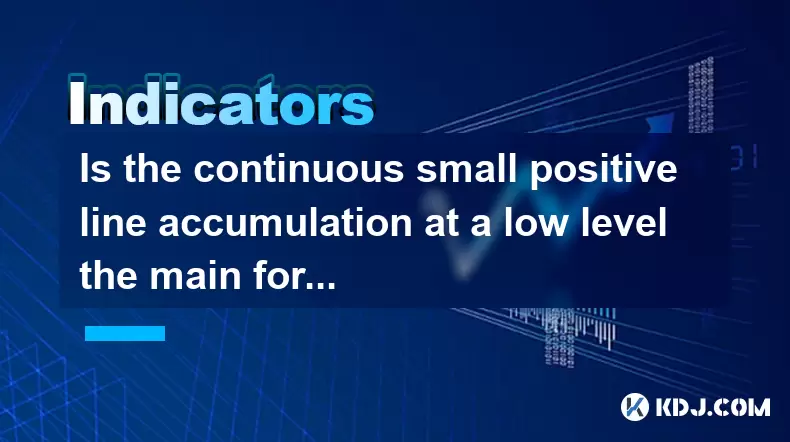
Is the continuous small positive line accumulation at a low level the main force to build a position?
Jun 30,2025 at 08:15pm
Understanding the Concept of Continuous Small Positive Line AccumulationIn cryptocurrency trading, continuous small positive line accumulation refers to a pattern where an asset experiences multiple consecutive candlesticks or bars that close higher than they open, but with relatively low volume and minimal price movement. This phenomenon is often obser...
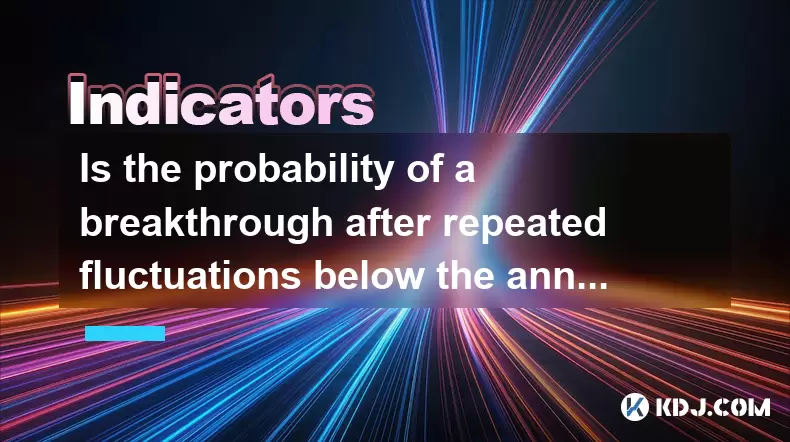
Is the probability of a breakthrough after repeated fluctuations below the annual line high?
Jun 30,2025 at 10:15pm
Understanding the Annual Line in Cryptocurrency TradingIn cryptocurrency trading, the annual line, also known as the 365-day moving average, is a critical technical indicator used by traders to assess long-term trends. This line serves as a dynamic support or resistance level depending on the price action around it. When the price of a cryptocurrency re...

Can I add positions if the daily line breaks through the descending channel + the 30-minute moving average is in a bullish arrangement?
Jun 30,2025 at 11:00pm
Understanding the Descending Channel BreakoutWhen a daily line breaks through a descending channel, it indicates a potential shift in market sentiment from bearish to bullish. A descending channel is formed by drawing two parallel trendlines, where the upper trendline connects the lower highs and the lower trendline connects the lower lows. A breakout o...

Should we guard against trend reversal when the monthly RSI is overbought + the weekly line has a long upper shadow?
Jun 30,2025 at 11:35pm
Understanding RSI Overbought Conditions in CryptocurrencyThe Relative Strength Index (RSI) is a momentum oscillator commonly used in technical analysis to identify overbought or oversold conditions in an asset. When the monthly RSI of a cryptocurrency reaches above 70, it is generally considered overbought, suggesting that the asset may be due for a pul...

Is the monthly RSI bottom divergence + the weekly morning star a bargain hunting opportunity?
Jun 30,2025 at 09:57pm
Understanding RSI Bottom Divergence in Monthly TimeframesThe Relative Strength Index (RSI) is a momentum oscillator commonly used to identify overbought or oversold conditions in the market. When traders refer to a monthly RSI bottom divergence, they're observing a situation where the price makes a lower low, but the RSI makes a higher low on the monthl...

Should you leave the market when the volume is stagnant and the MACD diverges?
Jun 30,2025 at 09:36pm
Understanding Volume Stagnation in Cryptocurrency TradingIn the realm of cryptocurrency trading, volume plays a crucial role in determining the strength of price movements. When volume remains stagnant over an extended period, it suggests that neither buyers nor sellers are showing strong conviction. This often leads to sideways movement or consolidatio...

Is the continuous small positive line accumulation at a low level the main force to build a position?
Jun 30,2025 at 08:15pm
Understanding the Concept of Continuous Small Positive Line AccumulationIn cryptocurrency trading, continuous small positive line accumulation refers to a pattern where an asset experiences multiple consecutive candlesticks or bars that close higher than they open, but with relatively low volume and minimal price movement. This phenomenon is often obser...

Is the probability of a breakthrough after repeated fluctuations below the annual line high?
Jun 30,2025 at 10:15pm
Understanding the Annual Line in Cryptocurrency TradingIn cryptocurrency trading, the annual line, also known as the 365-day moving average, is a critical technical indicator used by traders to assess long-term trends. This line serves as a dynamic support or resistance level depending on the price action around it. When the price of a cryptocurrency re...
See all articles

























































































